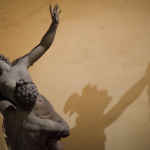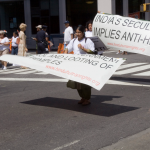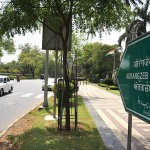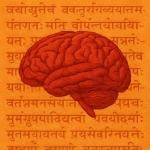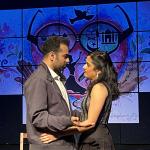
But this what Durga Pujo does to you, it makes you defy logic and let go of your sanity. You drape yourself in your finest saris, walk endlessly in your impossibly high heels and strangely you don’t mind the discomfort, the jostling crowds, the heat and the dust. It is as if you have been seized with this invisible energy. You patiently stand in serpentine queues, get busy checking each other out surreptitiously, no jostling, no pushing, only to catch a glimpse of the superbly crafted pandals and Maa Durga’s protimaa. And then with sweat-streaked backs you make a beeline for the food stalls. Devour platefuls of oily biryani, take a far from delicate bite of that fish chop and happily slurp masala chuski! Ahh… divine.
Even though Durga Pujo is a Hindu festival, religion takes a back seat for these five days. For us it is Eat, Pray and Love with a vengeance but unlike Elizabeth Glibert we don’t need to traverse continents, it happens right next door. The preparations start weeks ahead. Hectic shopping for new clothes, endless practice for cultural programmes and as weeks pass, the air fills with the mild fragrance of shiuli flowers, giving a familiar tug to every Bengali heart. In Delhi, every block, every neighbourhood has its own Pujo. From Shoshti through Doshomi, the community gets together to immerse itself in revelry. Shoshti, the first day of the Pujo starts with Anondo Mela where the bhodromohilas set up food stalls and showcase their cooking skills. Me, I do what am best at…eat. Mornings start with anjoli (prayers), followed by lots of adda, contests (including some really crazy ones) and ends with bhog. In the evenings, the pandal gets transformed into a cultural hotspot. People turn up in their finest silks, to watch and applaud the efforts of local and professional artists. We get to watch our ‘kaku kakimas’ enact plays, see our children give their maiden dance recital misty eyed and also enjoy performances by some of the finest artists from all over the country (Indian Ocean, Euphoria, Bandish, Cactus to name a few). For any Bengali kid, this is where your mom gets to show off her child’s talents. From reciting poetry in an emotion choked voice, to singing Robindro Shongeet, to playing the traumatized heroine in a dance drama (I forget which one, just remember the immensely sad expressions I had to portray) – I have done it all. Three Pujos back, me and my Mashi participated in an Antakshari competition and managed to win, despite our rather slim repertoire of filmy songs and mostly made up lyrics (we put up a convincing act and made it sound like the real thing).
For me, the best part is watching the dhakider naach. The dhakis form a circle and start swaying to the rhythmic beats of their dhaak adorned with feathers and gradually reach a crescendo while the crowds watch on mesmerized. There is something very primal about the frenzied beats, it captivates you and fills your heart with elation. And the dhunuchhir naach (a torch filled with fragrant dhuno) that is performed by devotees to invoke the blessing of the Goddess. Only in a Durga Pujo Pandal will you spot so many round faced strikingly beautiful women, their almond shaped eyes shining with excitement, their foreheads dotted with an extra large bindi, shimmering in their beautiful dhaakais, jabbering excitedly.
When it’s time to bid adieu to Maa Durga we cannot but hold back our tears. Thousands turn up at the banks of river Yamuna to give her an emotional farewell. In the evening we all congregate in the now desolate pandaal, hugging each other and touching the feet of our elders to wish them Shubho Bijoya. We have some more mishtee and goodies to drown our sorrows. And wistfully we wait for yet another year of Pujo madness.
Shubho Bijoya to all of you.




